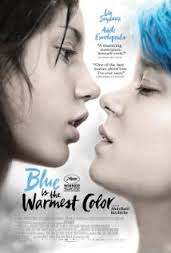- Beautifully acted and shot, Blue Is The Warmest Color is an emotional romance-drama that could have used additional editing to tighten its narrative.
- The two lead characters, Adele (Adèle Exarchopoulos) and Emma (Léa Seydoux) are three-dimensional, well written individuals about whom we care and with whom we identify.
- The actors playing them are even better. Both Exarchopoulos and Seydoux are emotionally riveting, and the two women share extraordinary chemistry that adds tremendous weight to the picture. 2013 has featured many movies with terrific performances, but the stars of Blue Is The Warmest Color are equal to all of them. They are worth the price of admission on their own.
- Though they are far from the film’s only strength. The ways Director Abdel Kechiche uses the color blue is downright fascinating. At times the color represents comfort for Adele, but at other times it isolates her. The mixed symbolism is powerful, and could fuel plenty of academic debate.
- Even more impressively, the relationships in this feature feel like real teenage connections, perhaps even more so than The Spectacular Now’s.
- Along those lines, we feel like Adele is a real person living a real life. It’s a rare movie that can be so true to reality.
- Love is powerfully portrayed here.
- All of which means this film is equally impacting and entertaining.
- Yet, Blue Is The Warmest Color also misses some opportunities. First, the narrative is repetitive and often devoid of obvious conflict. For most of the film, the primary tension is between Adele and herself, as she struggles to find her identity. Her search for self is ripe for gripping narrative, but it is overplayed here. We see Adele struggle with the same questions in many of the same ways in far too many scenes.
- Conflict between Adele and Emma is underplayed. These two young women have almost nothing in common, other than an extreme physical attraction to the other, but it still takes almost two and a half hours real time and several years narrative time before they argue. When they finally do, the screenplay, director and actors produce one of the most disturbingly real lovers’ quarrels I have ever seen on film, indeed maybe the most powerful scene in any movie this year. But it takes too long to get there. The conflict is brewing for so long that we can see it coming, which means we anxiously wait for it and wonder why it hasn’t arrived yet.
- I also puzzle over the disappearance of seemingly important characters. When Adele and Emma first meet, the latter is in a long term relationship with someone named Sabine. Yet, quickly enough, Sabine disappears. We never see or hear about her again. Why? The same thing happens with Adele’s parents and friends, including the one with whom she attends a gay bar and another with whom she engages in behavior that sparks the only argument between she and Emma. Again, why?
- Thus far I have intentionally avoided mentioning the sex scenes, because they are not the heart of Blue Is The Warmest Color, so I do not want them to be the heart of my review. Still, I’d be remiss if I didn’t comment on them.
- The greatest element working in this picture’s favor is that it feels true to life in almost every way. Except, I’d argue, in the sex scenes between Adele and Emma. These scenes are too cinematically perfect, too focused on making the women’s intercourse beautiful, and on placing the actor’s bodies in the perfect light and positions so as to maximize eroticism.
- I understand the artistic value of the love scenes. They show us the power of an overwhelming physical attraction, and thereby help us understand the nature of Adele’s relationship with Emma. My problem, then, isn’t that the sex scenes exist. It’s that they are filmed in a way that doesn’t feel genuine. Kechiche makes their love-making feel like a heterosexual man’s fantasy of lesbian sex, not like a realistic portrayal. I think this is a directorial misstep, given that Blue Is The Warmest Color aims for and achieves such realism everywhere else.
- For all of that, Blue Is The Warmest Color is an intense romance drama and worth viewing. It is good to very good as is.
- With some additional editing, however, it might have been great.
- Final Grade: B-
-
Subscribe
Subscribed
Already have a WordPress.com account? Log in now.

Nice review. You make a very good point about characters appearing and then disappearing, and that their quarrel near the end while good does take too long to get there.
Thank you!
Been anticipating this for quite awhile, still eager to check it out. It’s interesting that you make that point about the sex scenes seemingly been filmed in a vein of heterosexual male fantasy — because apparently both Exarchapolous and Seydoux have stated in interviews that they swear they will never work with this director again.
I saw that, actually. It’s notable that both women also complained as much about his general bullying as they did about the sex scenes themselves. Still, Seydoux says he made her feel like a prostitute.
Two sides to every story, of course, but I know that isn’t how I hope to make the females in my life feel.
Oh and this is still a good movie. You should totally see it.
Very excited to see this.
Seeing it this weekend!
Definitely worth viewing. It isn’t as great as it might have been, but it is still a quality flick.
I’ve not seen the film so can’t say too much, but your points sound valid and highly astute
Thank you. If and/or when you see it, let me know your thoughts. 😉